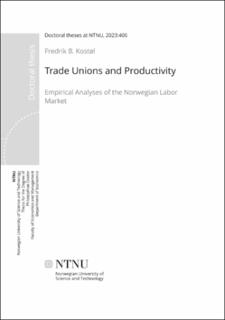| dc.contributor.advisor | Torvik, Ragnar | |
| dc.contributor.advisor | Holtskog, Halvor | |
| dc.contributor.author | Kostøl, Fredrik Bakkemo | |
| dc.date.accessioned | 2024-01-16T16:50:04Z | |
| dc.date.available | 2024-01-16T16:50:04Z | |
| dc.date.issued | 2023 | |
| dc.identifier.isbn | 978-82-326-7509-8 | |
| dc.identifier.issn | 2703-8084 | |
| dc.identifier.uri | https://hdl.handle.net/11250/3111982 | |
| dc.description.abstract | This thesis is concerned with the question of how trade unions influence the productivity of firms and workers. To answer this question, I utilize rich administrative register data from Norway to investigate how unions influence technology adoption, skill formation, and ultimately productivity at the firm level in three separate research papers. In the first article, we develop a theoretical framework that highlights two important mechanisms through which unions may influence technological change. By exploiting exogeneous variation in the tax rules for union members, we show how unions affect the structural composition of occupations within workplaces by altering relative wages. Moreover, our results suggest that unions influence relative labor demand conditional on relative wages. This finding gives support to bargaining theories where unions force firms off their demand curves.
The second article investigates the impact of unions on skill formation, as measured by participation in tertiary vocational education among full-time employees. In contrast to most existing studies, which rely on data from surveys, my data comprise the entire working population over a period of 16 years, allowing me to control for unobserved individual heterogeneity. An increase in the workplace union density is estimated to raise the individual propensity to participate in tertiary vocational education. I also find that workers in unionized establishments enjoy higher salaries during further education, but at the expense of lower post-training wage premiums. In addition, employee turnover is found to be lower in more unionized establishments. Together, these findings give support to the hypothesis that union wage compression provides firms with incentives to sponsor investments in workers’ skills in the absence of perfect competition in the labor market.
In the third article, we investigate how unions influence the productivity of firms, and how this relationship is affected by the quality of industrial relations as measured by the presence of a collective agreement. In the absence of an agreement, higher union density is estimated to reduce productivity. However, this effect is moderated, and in some cases turned positive, if a collective agreement is implemented in the firm. Our results indicate that the presence of a collective agreement and a sufficiently high union density combined have a positive impact on firm-level productivity. | en_US |
| dc.language.iso | eng | en_US |
| dc.publisher | NTNU | en_US |
| dc.relation.ispartofseries | Doctoral theses at NTNU;2023:406 | |
| dc.relation.haspart | Paper 1: Kostøl, Fredrik Bakkemo; Svarstad, Elin. Trade Unions and the Process of Technological Change. Labour Economics 2023 ;Volum 84. Published by Elsevier B.V. This is an open access article under the CC BY license. | en_US |
| dc.relation.haspart | Paper 2: Kostøl, Fredrik Bakkemo. Do Unions Increase Participation in Further Education? EEA-ESEM 2023, Barcelona, Spain. | en_US |
| dc.relation.haspart | Paper 3: Svarstad, Elin; Kostøl, Fredrik Bakkemo. Unions, collective agreements and productivity: A firm‐level analysis using Norwegian matched employer–employee panel data. British Journal of Industrial Relations 2022 ;Volum 60.(4) s. 864-894. Published by Wiley. This is an open access article under the CC BY-NC-ND license. | en_US |
| dc.title | Trade Unions and Productivity. Empirical Analyses of the Norwegian Labor Market | en_US |
| dc.type | Doctoral thesis | en_US |
| dc.subject.nsi | VDP::Samfunnsvitenskap: 200::Økonomi: 210::Samfunnsøkonomi: 212 | en_US |
